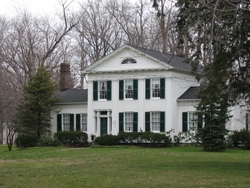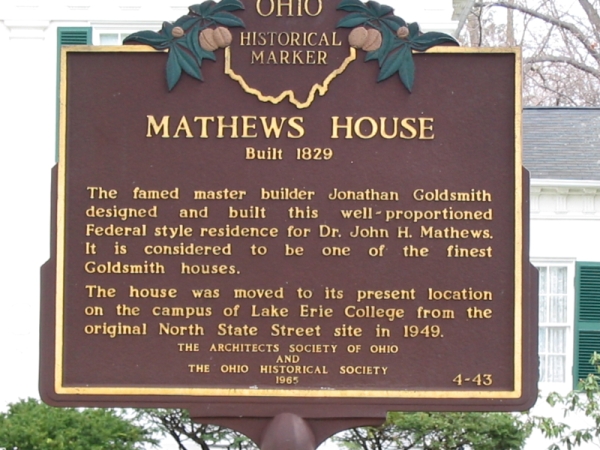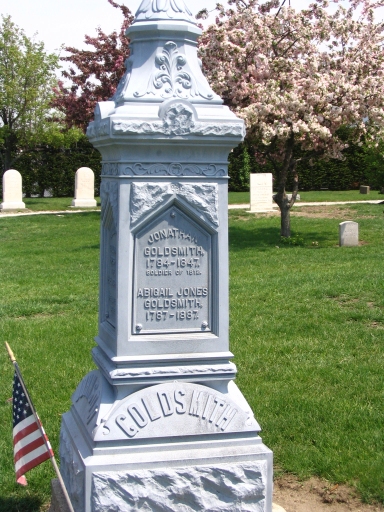In 1805, he went into business for himself, first in Hebron, CT, and later in Hinsdale, MA. In 1808, he married Abigail Jones, and in 1811, he, his wife and their two eldest children followed many of Mrs. Goldsmith's family members to Painesville, OH. At first, he was only able to find work as a cobbler, and when the War of 1812 broke out, he volunteered for service. After returning home, he went on to become a well-known architect and builder in the area of Ohio once known as the Connecticut Western Reserve.
Goldsmith's buildings include 30 homes and commercial buildings in Painesville, another handful around Lake County, and 10 houses in Cleveland. Many still exist today, although many more have been demolished. The front doorway of one of those razed homes, known as the Isaac Gillet House, has been exhibited at the Cleveland Museum of Art. His drawings were also included in an exhibition at the Metropolitan Museum's titled "The Greek Revival in the United States" in 1943. His work is better documented than many other 19th century builders due to the efforts of his daughter Lucia, who preserved his drawings and other manuscripts. Many of his personal and professional papers are stored at the Western Reserve Historical Society in Cleveland.
He was also known as a mechanic and farmer, and he is credited with inventing a multiple plow. While visiting his son, Gillett Goldsmith, who lived in Bexar County, TX, he obtained a patent from the Republic of Texas on May 7, 1840. In later years, Goldsmith suffered financial setbacks resulting in his selling his home, which he had built himself in 1818, as well as 86 acres of land. His final building project was the creation of a smaller house, later known as "Ingleside" where he lived until his death. The home was purchased in 1911 by the Lake County Agricultural Society as part of a parcel of 36 acres that is now the Lake County Fairgrounds. It was destroyed by fire in 1929. Jonathan Goldsmith was buried in the Painesville Twp Cemetery (now known as the Mentor Avenue Cemetery), located less than a mile from his home.
In 1805, he went into business for himself, first in Hebron, CT, and later in Hinsdale, MA. In 1808, he married Abigail Jones, and in 1811, he, his wife and their two eldest children followed many of Mrs. Goldsmith's family members to Painesville, OH. At first, he was only able to find work as a cobbler, and when the War of 1812 broke out, he volunteered for service. After returning home, he went on to become a well-known architect and builder in the area of Ohio once known as the Connecticut Western Reserve.
Goldsmith's buildings include 30 homes and commercial buildings in Painesville, another handful around Lake County, and 10 houses in Cleveland. Many still exist today, although many more have been demolished. The front doorway of one of those razed homes, known as the Isaac Gillet House, has been exhibited at the Cleveland Museum of Art. His drawings were also included in an exhibition at the Metropolitan Museum's titled "The Greek Revival in the United States" in 1943. His work is better documented than many other 19th century builders due to the efforts of his daughter Lucia, who preserved his drawings and other manuscripts. Many of his personal and professional papers are stored at the Western Reserve Historical Society in Cleveland.
He was also known as a mechanic and farmer, and he is credited with inventing a multiple plow. While visiting his son, Gillett Goldsmith, who lived in Bexar County, TX, he obtained a patent from the Republic of Texas on May 7, 1840. In later years, Goldsmith suffered financial setbacks resulting in his selling his home, which he had built himself in 1818, as well as 86 acres of land. His final building project was the creation of a smaller house, later known as "Ingleside" where he lived until his death. The home was purchased in 1911 by the Lake County Agricultural Society as part of a parcel of 36 acres that is now the Lake County Fairgrounds. It was destroyed by fire in 1929. Jonathan Goldsmith was buried in the Painesville Twp Cemetery (now known as the Mentor Avenue Cemetery), located less than a mile from his home.
Family Members
Advertisement
Records on Ancestry
-
U.S., War of 1812 Pension Application Files Index, 1812-1815
-
Massachusetts, U.S., Compiled Marriages, 1633-1850
-
Massachusetts, U.S., Compiled Birth, Marriage, and Death Records, 1700-1850
-
Massachusetts, U.S., Town and Vital Records, 1620-1988
-
Ohio, U.S., Soldier Grave Registrations, 1804-1958
Sponsored by Ancestry
Advertisement













